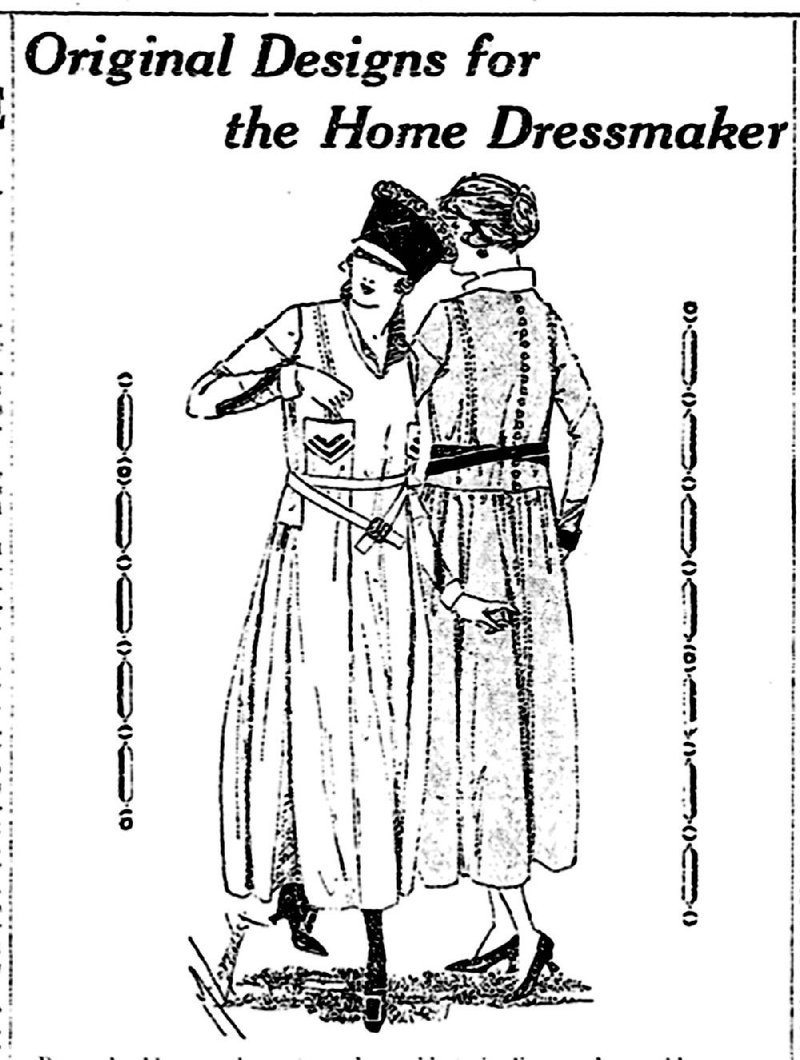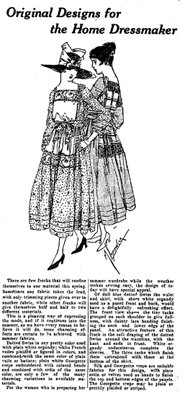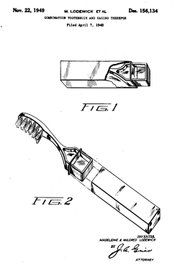Paging through 100-year-old issues of the Arkansas Gazette, past escaped murderers, bribery scandals, early crosswalks ... every so often you happen across some fine frocks.
I don't mean the clothes depicted in the marvelously drawn ads of the day. I mean sewing advice that showed up in the Gazette off and on from 1912 to 1919.
The frocks -- so detailed. The text -- so lacking in detail. Here's a for-instance, from the May 4, 1917, Gazette -- a month after Congress declared war on Germany:
Dress should not only portray character, but should reflect the psychological attitude of the times. Therefore styles that suggest the military or naval should be more especially favored just now by American women. True patriotism is revealing itself by means of many and diverse activities. Circumstances, however, may not permit all women to do as much as they would like in this respect, but they can at least manifest their patriotic feeling through the medium of their clothes.
Just a touch of military color, or a few brass buttons, or a bit of braiding, a military collar or belt, cartridge plaits of pockets -- there are any number of such details which would attest to the wearer's patriotism.
I have designed an especially smart little frock for today which I hope will appeal to many readers. A coarse weave of linen would be most adaptable to its lines, and army blue or gray are the most significant colors. The braid, or stitched band trimmings upon the pocket flaps and sleeves may be varied. On a blue frock they may be red and white, red and black, red and gray or black and gold. If gray was chosen for the color of the frock, the trimmings may be red and white, red and black, bright blue and white, or light blue and gold color. With brass or nickel buttons up the back, and a buckle to match in front, the effect is certain to be appealing. The military collar should be lined with one of the collars used for the braid trimmings.
Women who have been wary of military styles on account of their masculine and "forced" effect, will find this design appealing because of the very feminine way in which the masculine accoutrements of uniform have been incorporated.
I'm sure the writer intended us to line the collar with one of the "colors" used in the trimmings.
But who was the writer? Considering these sewing pieces usually crammed up against syndicated columns from The New York Evening World, a daily then owned by the sons of Joseph Pulitzer, I figured the writer also worked for the World. And that proved correct.
By 1916-17 the title was usually "Original Designs for the Home Dressmaker." Often it went unsigned, no byline, but her name was Mildred Lodewick, aka Mlle. Lodewick.
A lot of web browsing, an afternoon with the Central Arkansas Library System's free-to-patrons Ancestry.com account, and a week of ransacking the Gazette archive provide this sketch of her life:
Sarah Mildred and her sister Madeleine S. Lodewick were born Oct. 11, 1888, in Saratoga Springs, N.Y., to Cora B. and Marshall S. Lodewick.
An older brother, Earnest or Ernest, became a fine artist. In 1921, his tiny obituary in The New York Times claimed Charles Lodewick, an early mayor of New York, as an ancestor. So we can guess the twins claimed him, too. Ernest was buried at Saratoga Springs beside their father.
A merchant born on a farm about 1854, Marshall was dead by 1897. We know this because a patent filing that year for a fire escape he designed named Cora as "administratrix" of his estate. Cora and her three children lived in the village of Saratoga Springs and decades later continued to return there for social events.
In 1905, The Daily Saratogian reported that Mildred (then 17) had received a regents certificate for 12 high school "counts" (credits). In 1906, Madeleine also had a 12-count certificate, and Mildred had a 24-count. From this I gather Mildred was more often at school than her twin.
The 1910 Census had the widow Cora 44 years old and a boarder with her daughters in Manhattan, one of 14 lodgers at 249 W. 137th St. In Google Streetview today, this tree-lined street looks just like a set for rom-com movies about middle-class New Yorkers. Both young women stated their occupation as "costume designer," with Madeleine's line adding that she was a designer in a manufacturing house.
In later Census listings, the twins still lived together, in Manhattan, but the occupation of each became "sculptor."
In 1915, The Saratogian reported, "The Misses Madeline and Mildred Lodewick, of New York city, and this village, have been cleared of the shoplifting charge on which they were arrested in New York in January, and their case dismissed. Saratogians in general will receive this information with satisfaction as the many friends of the young women were unable to believe them guilty of the charge."
In December 1916, Editor & Publisher and The Fourth Estate carried items about ice-skating "scribes" that included Mildred and Madeleine, "fashion artists of the Evening World," among a number of well-known newspaper folk enjoying almost daily practice on the ice at St. Nicholas Rink.
The New York Social Blue Book for 1930 listed Mrs. Marshall S. Lodewick, Miss Mildred and Miss Madeleine all at 471 Park Ave.
Mildred's fashion reports and illustrations were syndicated to newspapers until 1931, when the World was sold. "The two sisters then went into business together as designers of dresses and other fashion items, which they sold to large stores" (according to Mildred's obituary in The New York Times).
The sisters Lodewick patented "Educational Device" (a paper doll), "Combination Toothbrush and the Casing Therefor" (travel toothbrush), "Receptacle for Lipsticks," "Tissue Dispensing Devices" (a metal Kleenex box) and my favorite, "Spectacle Retaining Device," a chain with loops on each end that slide over the temple bars of glasses, such as reading glasses, and allow said glasses to hang in front of the user's body.
After updating their toothbrush design, they fell out with the manufacturer, who refused to update their 5 percent royalty on net sales. In 1956, the 2nd Circuit U.S. Court of Appeals found for their opponents, Mavco Inc. and Fifth Avenue Plastics.
Age 80 and struggling with emphysema, Mildred died of a heart attack Dec. 13, 1968, in the apartment she shared with her sister for decades at 311 E. 53rd St. Madeleine died in 1974.
Their apartment house, erected the year they were born, still stands in New York's Midtown East. It has become an office building.
Next week: May Shoot at Pigeons That Harm Home Gardens
ActiveStyle on 05/08/2017



